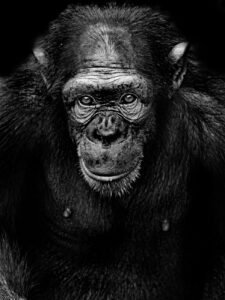Question? How do you tame a human? It takes 1 part early man, 1 part language, 2 parts culture and 5 parts time.
HI, my name is Tye Glover and welcome to Think Different Nation. SO, back to the question of “How Do You Tame A Human” or to put it in a different way, “How do you feel about the domestication of humans?” If you are bought into the idea that humans are just as much of an animal as any other living creature than it should not come as much of a leap of faith to know that we, at one time, were just as wild as any other primate.
Beginning back somewhere in the area of 100K years ago it is believed that homo-sapiens  experienced some type of transformation that allowed us to become what we are today – modern humans. There were many other humans that came and went before we emerged some 200,000 years ago but that first emergence of homo-sapiens … yielded a different kind of a wise human.
experienced some type of transformation that allowed us to become what we are today – modern humans. There were many other humans that came and went before we emerged some 200,000 years ago but that first emergence of homo-sapiens … yielded a different kind of a wise human.
Anthropologist believe this first “sapiens”, had the same brains as we do and visually were identical to us but it’s also believed that these first sapiens lacked one basic capability. Their ability to communicate complex messages. This first homo-sapiens known as Cro Magnons, According to Dr. Yuval Noah Harari professor in the Department of History at the Hebrew University, were identical to us but for some reason, the cake wasn’t fully baked as they left Africa and entered Europe. It’s believe that they were missing some primary cognitive abilities. That first migration entered into Europe somewhere in the area of 100,000 to 70,000 years ago as a failed experiment that ended with their extinction and with Neanderthals and other early humans winning out. Dr. Harari continues with the thought that while these first sapiens had the ability to create language, theirs was different from ours and they most likely would not have been able to learn our language and neither we, theirs. Outside of that, they would have fit right in at any dinner party that we would ever attend – as a silent guest.
But if we are animals, than what tamed us?
How did we transition to being the civilized species? The only way I could figure out how to explore this question was to study animal domestication but considering the domestication of the dog to the wolf took between 10,000 and 30,000 years, I obviously don’t have that type of time on my hands. So I went with an animal that was forced to domesticate and studied with great detail to understand that process.
The taming of the Siberian Fox:
The conception of this test began back in the 40s. Dmitry Konstantinovich Belyayev was a Russian geneticist who was interested in studying the behaviors and characteristics of domesticated animals which was illegal in Russia at the time. So he needed to have a way to hide his research and what better way to do that than to have a fox farm for the production of fox pelts for the fur industry. You see the premises here was that he would select and breed the most calm and docile foxes and the ones that displayed aggression would be used for their pelts for the thriving fur industry. This provided natural cover from government investigators who sought and persecuted anyone who was not abiding by government regulations.
geneticist who was interested in studying the behaviors and characteristics of domesticated animals which was illegal in Russia at the time. So he needed to have a way to hide his research and what better way to do that than to have a fox farm for the production of fox pelts for the fur industry. You see the premises here was that he would select and breed the most calm and docile foxes and the ones that displayed aggression would be used for their pelts for the thriving fur industry. This provided natural cover from government investigators who sought and persecuted anyone who was not abiding by government regulations.
During the first selection of foxes for the breeding process, researchers sought simply the one or two foxes that were the most approachable.
This started back in 1960 and while most foxes would instinctively growl and bare their teeth, the researchers looked for the least aggressive of the lot and each year, that’s exactly what they selected.
Once the first litter emerged it took two generations before the researchers recognized a subtle change in the offspring with the most obvious being the fact that they were more approachable and submissive as compared to other foxes. This was apparent by 1962.
By the fourth generation it was recognized that the selected off spring of young foxes showed obvious signs of tail wagging similar to dogs, when the researchers would appear. This was behavior that was uncommon to any other foxes and was visible just 4 years after the beginning of the experiment. Additionally, young foxes or kits as they are called, were docile enough to be picked up, petted and they would whimper with appreciation during the process.
By 1966 or the 6th generation the foxes were showing full affection to the researchers with the most affectionate ones following and licking the care takers when possible.
By the 9th generation or in 1969 the ears displayed differences when compared to the wild foxes. Normally the ears would stiffen just after birth but the test foxes retained soft ears for 3 months after birth. At this point there were obvious changes as well in the coats of the foxes being born with spotted fur and star shapes on the forehead.
By the 13th generation or by 1973 the fox’s tails began to curl up when they came into contact with humans as compared to the wild foxes whose tails pointed down upon contact.
By the 15th generation tails had become shorter by 3 to 4 vertebrae. Yes, that’s a structural change on the body and this occurred by 1975.
This first series of experiments lasted a total of 15 years or roughly 15 generations of forced selection. The journey of the domestication of humans lasted however for far longer and by some estimates, longer than 600 paternal grandmothers across 40,000 years. If you consider going back to the emergence of modern humans it could be as far back as 200,000 years ago which would be on par with 2,000 maternal grandmothers. And while the changes were significant from a modern sapient cognitive ability standpoint, the physical changes or rather hard wiring changes were subtle if recognizable at all.
But over the course of 15 years of domestication the fox lost 3 to 4 vertebrate during that period of time. That’s a size able structural change – a hard wiring change in such a short period of time that were not directed meaning these changes were not what the researchers were driving to create. They just occurred based on the foxes’ evolutionary system selecting specific traits for some reason that lead to these unintended changes.
If this is the case then why would we not expect homo-sapiens to undergo an even more significant structural change in at a minimum, our soft wiring – instinctive form, across a period of 40,000 to 70,000 years during our self-taming?
What I believe happened with humans is that we began to leverage our one truly different gift that propelled us to our current position. Our language. No other animal is able to express ideas or concepts which lead to beliefs, ideology, myths and culture and thus the entrance of the Cognitive Revolution.
Why was this important? Because we are also the only humans and apex predators to be able to live in large groups and being able to live within large groups is key to building civilizations – empires. But before we recognized this need, I believe we recognized that there is safety in numbers. Maslow’s hierarchy of needs suggest that the first things sapiens need are health, food, water, sleep, clothing and shelter. This is very difficult to achieve without community and different members doing different things.
But how did we achieve safety?
I mean we’re primates and primates are a violent species expressing numerous instances of genocide. And this is typical of primates. Jane Goodall spoke of this in her journals called the Gombe Chimpanzee War where a group of chimpanzees split causing one group to savagely target the smaller group over a 4 year period. During that conflict researchers captured very human behaviors of treachery, rage, celebration and terror. This disturbance led to subsequent territorial disturbances with another group until the aggressive group withdrew to its original area.
We’re all humans with an instinctive quest for self or group preservation. This still drives us even today. Somewhere in the area of 800K years ago humans developed the ability to control fire and that, many suggest led to the Cognitive Revolution because we were able to eat meat in a way that was more beneficial to rapid and more effective processing of those energy sources. That ability to be able to eat cooked meat meant that it broke down and processed more quickly which means there was less time required on any given day to just to satisfy Maslov’s hierarchical need for sustenance. With this came a change in our jab bones and jagged teeth becoming more smooth as there was less of a need for us to have to tear tough food products. This change took place over the next 600,000 years and many anthropologist believe that this increase in energy and efficiency in task led to the increased cognitive ability of the brain which led to the Cognitive Revolution beginning as sapiens first existed Africa in venture 2.0.
If the fox was able to lose 3 to 4 vertebrate over the course of 15 years of its domestication, surely sapiens would have been able to rewire our brains across 600K years as we moved out of Africa. But how did we learn to not just harness fire but rather create it? It was most likely learned through our 400,000 years of using it. I mean we all know it’s hot. A burned log will retain red hot embers for hours even when the actual flame isn’t present and if blown on, it can be re-ignited. But how does being able to control it translate to being able to create it? It am sure this was no more complex than sapiens taking a piece of stone for some reason, striking it against another stone and seeing sparks appearing that looked identical to the sparks that emerged from the camp fire that’s been observed daily for thousands of years. The thinking brain can easily make connections.
The forced evolution of the silver fox was something that also had unintended consequences that led to the disappearing and reappearing physical traits across the 15 years. The researchers began to believe that when you drastically change natural selection but selecting the breeding pairs, it has unintended consequences that cannot be calculated.
What was the consequences of taming fire?
The ability to extend the day into the night lead to the presentation of myths which led to rituals, legends and ideology around a common belief or story.
to the presentation of myths which led to rituals, legends and ideology around a common belief or story.
By learning how to harvest and control fire we radically changed the pressures of our existence and shook everything up leading to a whole suite of incalculable changes to follow. We moved away from Biology – instinct, exponentially towards Think, Innovate. This was a structural shift in evolution. And it came to the right species at the right time.
Sapiens are the only humans or for that matter, animals that can form in large groups around an abstract concept. We come together for common causes, travel to foreign lands to fight ideologies different from ours and protect our territories based on lines drawn on maps. As we migrated from hunter gatherer we became tame and transitioned from biology to ideology where thought drove our actions, considerations and decisions. While many of our instincts still yet to be discovered, our own blood lines developed specific soft wired instincts that were passed down through our lines and many are available even today within us. It’s up to us to identify what our own individual instinctive advantages are.
